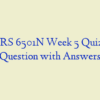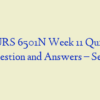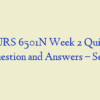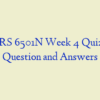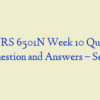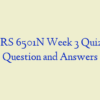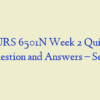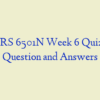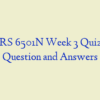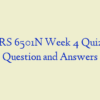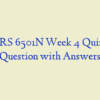Description
NURS 6501N Week 6 Quiz Advanced Pathophysiology (30 out of 30 points)
- A 53-year-old male with a 20-year history of smoking is diagnosed with emphysema. When a staff member asks why the patient’s airways are obstructed, how should the nurse respond? The airways are obstructed because of:
- A 20-year-old male presents to his primary care provider reporting difficulty breathing when lying down. What term should the nurse use to document this condition?
- A young patient is admitted to the pediatric unit with cystic fibrosis (CF) exacerbation. The nurse monitors the patient closely because the main cause of death in a child with CF is:
- A 65-year-old male recently had a cerebrovascular accident that resulted in dysphagia. He now has the aspiration of gastric contents. The nurse assesses the patient for which complication?
- A 50-year-old male presents with hypotension, hypoxemia, and tracheal deviation to the left. Tests reveal that the air pressure in the pleural cavity exceeds barometric pressure in the atmosphere. Based upon these assessment findings, what does the nurse suspect the patient is experiencing?
- An 11-year-old female presents with a low-grade fever and cough. She is diagnosed with atypical pneumonia. What type of pneumonia does the nurse suspect the patient is experiencing?
- A geneticist is discussing cystic fibrosis (CF). Which information should be included? CF is an _____ disease.
- If an individual with respiratory difficulty were retaining too much carbon dioxide, which of the following compensatory responses would the nurse expect to be initiated?
- While reviewing lab results, to help confirm a diagnosis of cystic fibrosis in a 1-year-old child which substance will be present in the child’s sweat?
- A 57-year-old male presents with cough, sputum production, dyspnea, and decreased lung volume. He is diagnosed with pneumoconiosis. When taking the patient’s history, which finding is the most probable cause of his illness?
- A 25-year-old male presents with chronic bronchitis of 5 months’ duration. When obtaining the patient’s history, which of the following findings is most likely to cause this condition?
- A 30-year-old female received a severe head injury in a motor vehicle accident. She is now experiencing respiratory abnormalities characterized by alternating periods of deep and shallow breathing with periods of apnea. What term should the nurse use when charting this condition?
- Which patient would the nurse assess for paroxysmal nocturnal dyspnea (PND)? A patient with:
- Individuals with a recent diagnosis of emphysema should be assessed for which most common presenting factor?
- A nurse is teaching staff about pulmonary edema. Which information should the nurse include? The most common cause of pulmonary edema is:
- Which of the following shows a correct cause and effect sequence in the development of acute respiratory distress syndrome (ARDS)?
- A 22-year-old female presents with chronic bronchitis. Tests reveal closure of the airway during expiration. While planning care, a nurse recalls this condition is most likely caused by:
- A newborn has respiratory distress syndrome. When obtaining the patient’s history, which of the following is the most important predisposing factor for this condition?
- A 65-year-old female with emphysema presents to the ER for difficulty breathing. Physical exam reveals bluish skin and mucous membranes. How should the nurse chart this condition? Patient has:
- A 42-year-old female presents with dyspnea; rapid, shallow breathing; inspiratory crackles; decreased lung compliance; and hypoxemia. Tests reveal a fulminant form of respiratory failure characterized by acute lung inflammation and diffuse alveolocapillary injury. Which of the following is the most likely diagnosis the nurse will observe on the chart?
- When the nurse is asked what causes asthma, how should the nurse respond? Asthma is thought to be caused by: nurs 6501n week 6
- A 60-year-old female with a 25-year history of smoking is diagnosed with emphysema. She has an increased anterior-posterior chest diameter. The nurse attributes this finding to:
- A 60-year-old female with emphysema is having difficulty expiring a given volume of air. When giving a report, the nurse will relay that the patient is most likely experiencing _____ pulmonary disease.
- A 25-year-old male presents with chronic bronchitis of 5 months’ duration. Which of the following is the most significant concern for the nurse to monitor in this patient?
- While planning care for a child with asthma, which of the following is characteristic of asthma? nurs 6501n week 6
- When the pulmonologist discusses the condition in which a series of alveoli in the left lower lobe receive adequate ventilation but do not have adequate perfusion, which statement indicates the nurse understands this condition? When this occurs in a patient it is called:
- A 9-year-old male contracted influenza. Which of the following complications is of greatest concern to the nurse?
- A nurse is preparing to teach the staff about asthma. Which information should the nurse include? Airway hyper-responsiveness in asthma is related to:
- A nurse recalls asthma is classified by:
- A 53-year-old male with a 20-year history of smoking is diagnosed with emphysema. When the nurse is asked what causes this, what is the nurse’s best response? Changes in his lungs are caused by:



